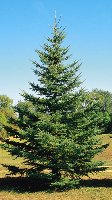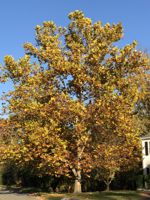Mon-Fri 9am - 5pm Mountain time
Black Hills Spruce vs American Sycamore
Picea glauca var. densata
Platanus occidentalis
NOT AVAILABLE THIS SEASON - MIGHT RETURN
Black Hills Spruce is a subspecies of White Spruce native to the Black Hills of South Dakota. It has a strongly conical form, slower growth rate and denser foliage than typical white spruce, making it preferable as a specimen tree for smaller suburban lawns. It also responds well to pruning, and can be used as a hedge or even bonsai.
American Sycamore is the largest tree native to eastern North America. Generally too large and messy to be a street tree, American Sycamore thrives in large, open spaces, such as an acreage or farm.
The bark is one of the main features that draw people to this tree. The outer bark flakes off in irregular pieces to reveal an attractive white, green, and cream colored inner layer, providing winter interest.
American Sycamore has an extremely fast growth rate, gaining up to 6 ft in one year, and will easily reach its mature height in a short period of time. Be wary of this trees' root system, as it's typically very extensive and needs lots of room to expand.
Black Hills Spruce Quick Facts
American Sycamore Quick Facts
In row spacing: 3 - 4 m (10 - 12 ft)

